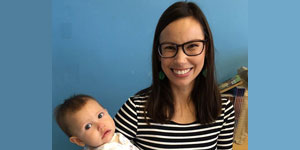Family Life
4 min Read
Fallon Melander of Wikwemikong First Nation helps native students in Toronto understand the law

June 20, 2016
Family Life
4 min Read

June 20, 2016

In the wake of the Truth and Reconciliation Commission, First Nations parents and activists work to erase the legacy of residential schools and look to the future.
Reporter Amber Nasrulla spoke with Fallon Melander, legal aid lawyer and an Ojibway of the Wikwemikong First Nation on Manitoulin Island. Fallon volunteers with Dare to Dream, a program created by Level Justice that aims to demystify the justice system to Aboriginal youth in Toronto. “We are trying to build students’ confidence,” she says.
 “Reconciliation is a huge component, and education of the youth and lawyer volunteers goes both ways.
“Reconciliation is a huge component, and education of the youth and lawyer volunteers goes both ways.
“Dare to Dream touches upon the education piece of the TRC. It empowers Aboriginal youth with knowledge of the law, the benefits of learning about the law, knowing their rights, and not reliving the past and going forward in a brighter future.
“We had one student last year apprehensive at the start. A family member was currently incarcerated so her experience with the justice system was oppressive and negative. We worked with her just as we work with all students. During the mock trial she had a role of defense lawyer and, at the end, announced she wanted to be a lawyer when she grew up.
“A lot of our mentors are senior lawyers, and they’re non-Aboriginal. They work in areas where they have Aboriginal clients, but they don’t understand the impact of residential schools and the impact the legal system has had until they enter this classroom.
“The students talk about their experiences of family members being in the Sixties Scoop. [From the 1960s to the 1980s an estimated 20,000 First Nations children in Canada were taken from their families for placement in foster homes, adoption, residential schools, or sent to the U.S.] The mentors has no idea this happened and they are realizing impacts of the past and how it affects these 13- and 14-year-olds. Hopefully, they take these stories home to their families and teach their kids.
“My grandmother went to a residential school and, upon release moved to Toronto. All of her children, except for one, were taken from her as part of the Sixties Scoop – including my mother who was five. She was adopted into a non-Native French-Catholic family in Oakville. She was very confused and was told, ‘Your mother can’t look after you.’ She definitely grew up with an identity crisis.
“She reunited with her birth mother shortly after I was born. But I didn’t have that connection with my culture or heritage growing up. The environment wasn’t around for me to be proud of who I am. It’s a sign of the times that things have changed in Canada recognizing Aboriginal peoples and our rights and the uniqueness of our culture.
“I take my one-year-old daughter, Madison, to the First Nations School during Dare to Dream. The kids love her and they fascinate her. At the beginning of the session, there is a smudge and she smudges. [A cleansing ceremony that involves the burning of medicines gathered from the earth – such as sweetgrass, sage and cedar.] She is in the culture from the get-go. My wish for her to is to grow up with a sense of pride, a sense of belonging and confidence in who she is as a girl, as a First Nations person, and as a Canadian.
“I hope she also takes time to educate people and to be open. I hope my passion for educating Aboriginal peoples is setting a good example.“
The Truth and Reconciliation Commission (TRC) has many goals, such as improving Indigenous lives through legal equity, supporting education and health programs, improving child welfare, and preserving Indigenous language, culture, and spiritual traditions.